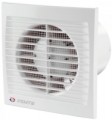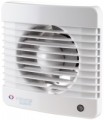Type of bearing
The type of bearing installed in the fan.
The bearing is a part that secures the rotating part of the fan to the stationary part and reduces friction between these parts. By type, it can be as follows:
— Plain bearing. The action of such bearings is based on the friction between two conjugated, that is, directly pressed one to the other over the entire area, surfaces. However, these surfaces are in contact with each other relatively weakly — between them is a layer of lubricant that reduces friction. In addition, to reduce resistance, rubbing parts are usually carefully polished and made of anti-friction materials. The main advantage of plain bearings is the simplicity of design and the resulting low cost. However, such parts are less durable than ball bearings, and they create more noise.
— Ball bearing. The principle of operation of a ball bearing is that a set of balls is placed between its movable and stationary parts, which roll inside during movement. Compared to plain bearings, such bearings last much longer, and they create less noise during operation. On the other hand, fans with similar equipment are noticeably more expensive.
Power consumption
The power consumed by the fan during normal operation.
This parameter primarily affects the power consumption of the device and the load on the power grid created during its operation. However, the latter is usually not critical, since the power of most modern fans is low. Also, the more powerful the device, the higher its performance(see above). However, there is no unambiguous dependence here — much is determined by how effective the design is. Therefore, models with the same performance can differ markedly in power consumption.
When choosing between two similar models with different power consumption, you should proceed with how often and for how long you plan to turn on the fan. If regular work is expected for a long time — for example, to ventilate the kitchen while cooking — you should pay attention to a less powerful model. It may cost more, but the price difference can quickly pay off in energy savings. If the fan turns on occasionally (for example, when installed in the bathroom of a residential apartment), you can not pay much attention to the power consumption.
Features
-
Pull cord switch. Pull cord switches, as the name suggests, operate using a cord pulling which turns the fan on/off. Such a switch is especially convenient in cases where the fan itself is installed high and it is difficult to reach its housing. In addition, it has another advantage common to all built-in switches - ease of connection: you do not have to mount a separate switch in the wall (or link the ventilation to the lighting), just connect the power to the fan. These models are recommended primarily in cases where the extractor fan is planned to be turned on quite often, but for a short time - for example, for installation in an ordinary home kitchen.
-
Non-return valve / shutters. The presence of a valve in the design of the fan or a system of automatic shutters. These types of equipment are combined into one item because they have the same purpose: to prevent the movement of air in the opposite direction — into the room — when the extractor fan is turned off. It allows, for example, to avoid unpleasant odours from entering the kitchen from the bathroom located behind the wall, using the same ventilation duct. The non-return valve is a characteristic "petal" that closes when air moves in the "wrong" direction. Automatic shutters open when the fan is turned on and close when it is turned off; they are considered a more advanced option, however, and cost accordingly.
-
Built-in clock. The clock in such models is installed directly on the extractor fan cover. Thus, the unit also plays the role of an ordinary wall clock. Such devices are designed for situations where the air duct opening is in a prominent place and it is undesirable to install a conventional cover there from a design point of view — they not only allow you to find out the time but also look quite aesthetically pleasing. Also, with the proper degree of moisture protection (see below), clock fans can be useful for the bathroom — especially for those who tend to stay in the shower or bath for a long time. But in other cases, it is easier to buy the clock and the fan separately.
-
Timer. The presence of a shutdown timer in the design of the fan. This feature, as a rule, is implemented as follows: after the shutdown command, the fan continues to work for some time and turns off only after the time for which the timer is set has passed (most often, the adjustment range is from 2 to 30 minutes). Thanks to this, you can safely leave the room that needs to be ventilated (for example, from the bathroom after a shower): you do not have to keep track of the time and return to the fan to turn it off, this will be done automatically.
-
Delayed start. The way this function works is described in the name itself: when it is used, the fan starts working some time after the switch-on command (usually this time is short — up to 2 minutes). The meaning of the delay is that the fan does not start immediately, but when the need for it becomes relevant. An example is a fan installed in the bathroom and tied to a light switch: in the first two minutes after entering the bathroom, the humidity is unlikely to rise much, and there is simply no need to start the hood, but with a longer stay it may be needed.
-
Humidity sensor. The presence of a humidity sensor in the design of the fan. This function is useful primarily in cases where the fan is used to remove excess moisture from the air — for example, in bathrooms. The sensor can provide both automatic switching on of the device with a significant increase in the amount of moisture in the air, and switching it off when the humidity decreases. In the latter case, it works similarly to the timer described above. However, it is more efficient, since the shutdown does not depend on time, but on reaching the desired conditions in the room. Specific features of this function in different models may vary.
-
Motion sensor. The presence of a motion sensor in the design of the fan. Such a sensor provides additional automation of on/off: it automatically starts the fan when people appear in the room. The shutdown can be carried out both by a combination of a sensor and a timer — with some delay after the movement in the room has stopped — and by a manual command from the user. The specifics of how this function works in different models may be different.
-
Light sensor. The light sensor provides additional automation for turning on/off the extractor fan. In particular, it automatically starts ventilation when the light is turned on in the room. Switching off can be carried out by a combination of a sensor and a timer — after the light is turned off, the fan continues to work for some time and turns off only after the time period for which the timer is set has passed.
-
Temperature sensor. This feature can be used in two main ways. The first one is similar to how the humidity sensor described above works: the device monitors the temperature in the room and, if necessary, turns on the fan, and turns it off when the need disappears. The second option is to work as a security system: if the supply air temperature is too low or too high, the sensor turns off the fan, protecting the device from damage due to abnormal operation. This option is especially relevant for models with air supply capabilities (see "Type").
-
Backlight. The presence in the design of the fan LED-backlight, activated in conjunction with the inclusion of ventilation. The lighting system allows you to gently designate the product, and emphasize the colour of the cover and the texture of the material. In addition, the backlight looks stylish in low light or off.
The above list is not exhaustive, and other additional features may be provided in the design.
Cover height
The size of the decorative fan cover in height.
For details on the features of such panels in different types of fans, see "Cover diameter". The same size is indicated in cases where the panels are in the shape of a square or rectangle (see "Cover shape").
Cover width
The size of the decorative fan cover in width.
For details on the features of such panels in different types of fans, see "Cover diameter". The same size is indicated in cases where the panels are in the shape of a square or rectangle (see "Cover shape").
Cover thickness
The size of the decorative fan cover in thickness.
This parameter describes how much such a panel protrudes above the surface of the wall or ceiling on which the fan is installed. For more information about the general features of decorative panels in different types of fans, see "Cover diameter".
Mounting depth (duct)
Mounting depth of the fan with a standard installation method.
This parameter describes how deep into the duct the unit (or its parts in the case of surface-mounted models, see "Type") is placed during installation. Knowing the mounting depth, it is possible to assess the suitability of the selected model for a particular installation location: a flat section at the very beginning of the duct must be no less than the installation depth of the selected fan.
The smallest value of this parameter is typical for some overhead models of fans: in them, the main part of the structure is outside, and usually, only 2-3 centimetres are required for installation. And most of all, hidden units require space (see "Type").

